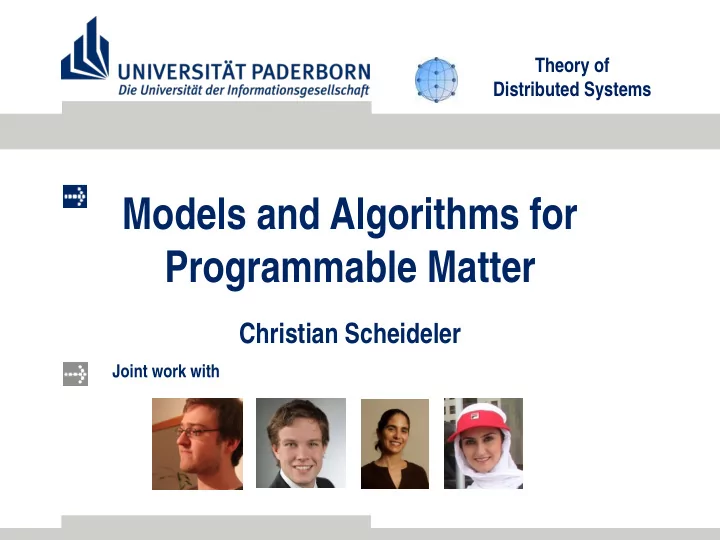

Theory of Distributed Systems Models and Algorithms for Programmable Matter Christian Scheideler Joint work with
Theory of Distributed Systems Motivation Scene with T1000 from Terminator 2 Movie: Primitives? Algorithms? 2
Theory of Distributed Systems Motivation 3
Theory of Distributed Systems Motivation – Programmable Matter Today Modular and swarm robotics: Prismatic cubes Kilobots M-blocks 4
Theory of Distributed Systems Motivation - Applications 5
Theory of Distributed Systems Basic Problems Shape formation: Coating problems: 6
Theory of Distributed Systems Towards a model for programmable matter Our basic approach: Programmable matter consists of simple, intelligent particles that can move, bond, and exchange information through bonds 7
Theory of Distributed Systems Towards a model for programmable matter At all times, particles have to form connected structure Which structure to form? How to move along a given structure? Can a particle drag other particles with it? 8
Theory of Distributed Systems Towards a model for programmable matter Candidates for the structure formed by the particles: … or even irregular structures 9
Theory of Distributed Systems Towards a model for programmable matter Problem with latter two grids: Some particles cannot move along edges without losing connectivity … but maybe it would also be fine to do diagonal movements 10
Theory of Distributed Systems Towards a model for programmable matter But how can two diagonally moving particles pass each other? … so it seems best to use triangular grid 11
Theory of Distributed Systems Towards a model for programmable matter How to move while maintaining a rigid structure for the other particles? 12
Theory of Distributed Systems Towards a model for programmable matter How to move while maintaining a rigid structure for the other particles? Also, how to handle conflicting movements? 13
Theory of Distributed Systems Towards a model for programmable matter Solution: use extensions and contractions 14
Theory of Distributed Systems Towards a model for programmable matter Solution: use extensions and contractions In case of a conflict, go back to the previous position → allows us to handle concurrency! 15
Theory of Distributed Systems Towards a model for programmable matter Other assumptions: Particles have limited (constant) memory and initially do not have any global information about the system Particles have common chirality, but no global orientation Particles are activated in an asynchronous fashion Particles can only communicate via bonds Name of our model: Amoebot model 16
Theory of Distributed Systems Towards a model for programmable matter We do not consider: Energy Fault-tolerance Gravity (just 2D) Name of our model: Amoebot model 17
Theory of Distributed Systems Relationship with other models Existing models insufficient for programmable matter. Cellular automata Static cell-based view, not agent-based view DNA self-assembly, population protocols, … No controlled movements Swarm robotics No connectivity, powerful sensing Nubot model (Woods, Chen, Goodfriend, Dabby, Winfree, Yin 2013) Particle can drag others with it 18
Theory of Distributed Systems Problems considered here Leader Election Shape Formation 19
Theory of Distributed Systems Why Leader Election? It is easy to show: Line formation solvable ⇒ Leader election solvable Hence, Leader election not solvable ⇒ Line formation not solvable ⇒ Ability to elect leader crucial for suitability of prog. matter model Is geometric information (regular structure, chirality) needed? Itai & Rodeh [FOCS’81]: leader election cannot be solved in our model without geometric information (since it is impossible on the cycle). Hence, also line formation is not solvable without geometric information. 20
Theory of Distributed Systems Leader Election - The Big Picture 21
Theory of Distributed Systems Leader Election – Subphase 1 22
Theory of Distributed Systems Leader Election – Subphase 1 23
Theory of Distributed Systems Leader Election – Subphase 2 0 1 24
Theory of Distributed Systems Leader Election – Subphase 3 25
Theory of Distributed Systems Leader Election – The details For the local protocol lots of issues have to be resolved. The main challenges are: 1. Segment length comparison 2. Candidacy transferal 3. Solitude verification 4. Inner/Outer Boundary Test Solutions rely heavily on token passing schemes and the regularity of the grid graph. 26
Theory of Distributed Systems Leader Election – Solitude verification y x 27
Theory of Distributed Systems Leader Election – Inner/Outer Boundary Test ∑ = +360° ≙ +6 = 1 𝑛𝑛𝑛 5 ∑ = − 360° ≙ − 6 = 4 𝑛𝑛𝑛 5 28
Theory of Distributed Systems Leader Election With the ability of LE a lot of problems get easier: Shape Formation Majority 29
Theory of Distributed Systems The Takeaway Slide The Amoebot model is a simple and reasonable model to study programmable matter. There is an interesting connection between having geometric information and solving leader election. Leader election and shape formation are intrinsically related. 30
Theory of Distributed Systems Questions? 31
Recommend
More recommend